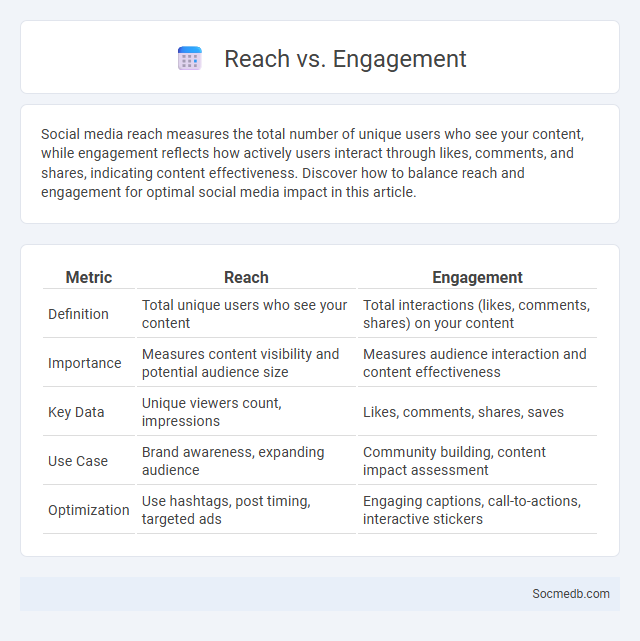
Photo illustration: Reach vs Engagement
Social media reach measures the total number of unique users who see your content, while engagement reflects how actively users interact through likes, comments, and shares, indicating content effectiveness. Discover how to balance reach and engagement for optimal social media impact in this article.
Table of Comparison
| Metric | Reach | Engagement |
|---|---|---|
| Definition | Total unique users who see your content | Total interactions (likes, comments, shares) on your content |
| Importance | Measures content visibility and potential audience size | Measures audience interaction and content effectiveness |
| Key Data | Unique viewers count, impressions | Likes, comments, shares, saves |
| Use Case | Brand awareness, expanding audience | Community building, content impact assessment |
| Optimization | Use hashtags, post timing, targeted ads | Engaging captions, call-to-actions, interactive stickers |
Understanding Reach and Engagement
Understanding reach on social media involves measuring the total number of unique users who see a post, which helps gauge brand visibility. Engagement refers to the interactions such as likes, comments, shares, and clicks that users perform, indicating content relevance and audience connection. Tracking both metrics provides insights into campaign effectiveness and audience behavior, enabling data-driven content strategy improvements.
What is Social Media Reach?
Social media reach refers to the total number of unique users who view a particular piece of content or advertisement across platforms like Facebook, Instagram, Twitter, and LinkedIn. It measures the potential audience size exposed to posts, helping marketers gauge campaign effectiveness and brand visibility. Understanding social media reach is crucial for optimizing content strategies and maximizing engagement with target demographics.
Defining Engagement in Social Media
Engagement in social media refers to the measurable interactions between users and content, including likes, comments, shares, and clicks. High engagement rates indicate active audience participation and are critical metrics for evaluating content effectiveness and brand resonance. Social media platforms use engagement algorithms to prioritize content that generates meaningful user interactions, boosting visibility and reach.
Key Differences Between Reach and Engagement
Reach represents the total number of unique users who see your social media content, serving as a measure of potential audience size. Engagement quantifies the interactions users have with your content, including likes, comments, shares, and clicks, reflecting how effectively your message resonates. Understanding the distinction between reach and engagement helps you optimize your social media strategy to not only attract viewers but also foster meaningful interactions.
Why Both Reach and Engagement Matter
Reach determines the size of the audience exposed to social media content, impacting brand awareness and potential customer acquisition. Engagement measures the interaction level, such as likes, comments, and shares, reflecting audience interest and fostering trust. High reach combined with strong engagement amplifies message effectiveness and drives valuable conversions.
How to Measure Reach Effectively
To measure social media reach effectively, track the total number of unique users who view your content across platforms like Facebook, Instagram, and Twitter using built-in analytics tools such as Facebook Insights and Twitter Analytics. Analyze impressions and engagement metrics alongside reach to gain a comprehensive understanding of your audience's exposure and interaction with posts. Utilize UTM parameters and third-party tools like Google Analytics to attribute and validate reach from social campaigns accurately.
Strategies to Boost Social Engagement
To boost social engagement, focus on creating compelling, shareable content tailored to your target audience's interests and behaviors. Utilize interactive elements like polls, quizzes, and live videos to encourage active participation and foster community connections. Monitor analytics closely to refine your approach, ensuring your strategies align with Your audience's preferences and drive meaningful interactions.
Common Misconceptions: Reach vs. Engagement
Reach measures the total number of unique users who see your social media content, while engagement tracks interactions such as likes, comments, shares, and clicks. Many assume a high reach automatically leads to high engagement, but your content's relevance and resonance with the audience are crucial factors that drive meaningful interaction. Understanding the distinction between reach and engagement helps you optimize strategies to build a loyal and active community rather than just a passive audience.
Which Metric is More Important for Your Goals?
Choosing the right social media metric depends on your specific goals; for brand awareness, reach and impressions are key indicators. Engagement metrics such as likes, comments, and shares provide insight into audience interaction and content resonance. Conversion rates and click-through rates become critical when aiming to drive sales or lead generation from social media campaigns.
Balancing Reach and Engagement in Your Campaigns
Maximizing campaign success requires balancing reach and engagement by targeting the right audience segments with tailored content on platforms like Facebook, Instagram, and Twitter. Leveraging analytics tools to monitor key performance indicators such as click-through rates, shares, and comments helps refine strategies for optimal interaction without sacrificing audience breadth. Prioritizing high-quality, relevant posts combined with timely responses enhances user experience and drives sustained engagement while expanding overall reach.
 socmedb.com
socmedb.com